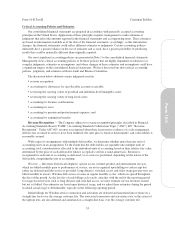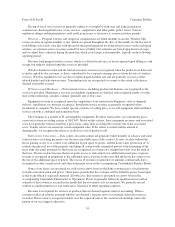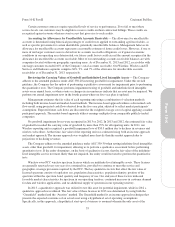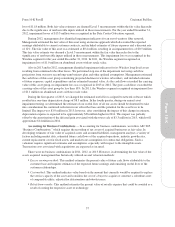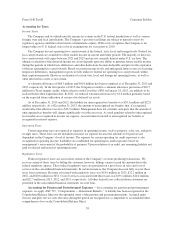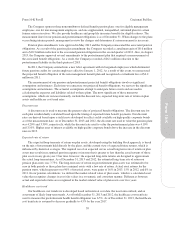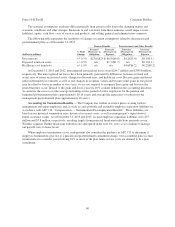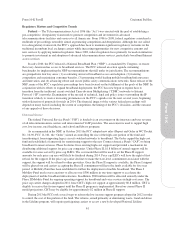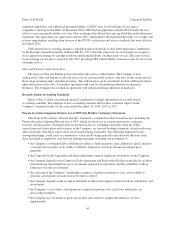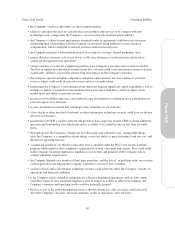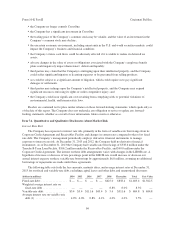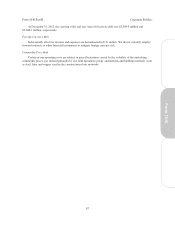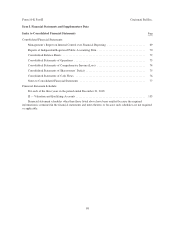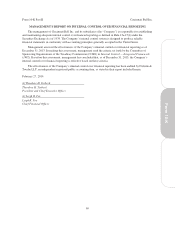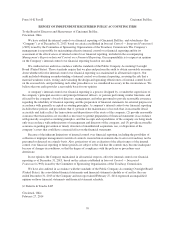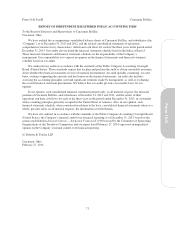Cincinnati Bell 2013 Annual Report Download - page 143
Download and view the complete annual report
Please find page 143 of the 2013 Cincinnati Bell annual report below. You can navigate through the pages in the report by either clicking on the pages listed below, or by using the keyword search tool below to find specific information within the annual report.
Form 10-K Part II Cincinnati Bell Inc.
access charges. These changes have had relatively insignificant and offsetting impacts within the Company.
During the FCC’s examination of the transition from TDM to IP networks, the regulatory status of VoIP and
interconnection rights for VoIP providers will be addressed. The outcome of this examination and the ultimate
transition plan adopted could have positive and/or negative consequences for virtually all providers of TDM and
IP-based services.
Broadband Internet Access/Net Neutrality
In an order adopted in 2005, the FCC provided wireline carriers the option of offering broadband Internet
access as a non-regulated information service (comparable treatment to cable modem Internet access) or as a
regulated telecommunications service. In 2007, CBT elected the non-regulated information service designation
for its broadband Internet access service. The FCC also ruled that wireless broadband service is a non-regulated
information service, placing it on the same regulatory footing as other broadband services such as cable modem
service and wireline DSL service.
In conjunction with the adoption of the 2005 wireline broadband Internet access order, the FCC adopted a
policy statement intended to ensure that broadband networks are widely deployed, open, affordable, and
accessible to all consumers. In 2009, the FCC opened a proceeding to codify the “net neutrality” principles
established in the 2005 policy statement. However, in April 2010, the D.C. Circuit Court of Appeals issued an
opinion finding that an FCC enforcement action regarding Comcast’s network management practices exceeded
the FCC’s authority, causing the FCC to reassess its approach to crafting net neutrality rules. In December 2010,
the FCC adopted net neutrality rules that require broadband providers to publicly disclose network management
practices, restrict them from blocking Internet content and applications, and prohibit fixed broadband providers
from engaging in unreasonable discrimination in transmitting traffic. The rules took effect in 2011, and although
appeals of these rules were filed, most broadband providers, including our Wireline and Wireless operations
implemented procedures to comply with the rules. In January 2014, the D.C. Circuit Court of Appeals vacated
the Net Neutrality order’s anti-blocking and anti-discrimination requirements finding that they are akin to
common carrier regulation. However, the Court upheld the transparency and disclosure requirements and found
that the FCC has general authority under Section 706 of the Communications Act to promulgate rules to
encourage broadband deployment. The Company foresees little impact from the decision in the near-term,
however, it does open the door for companies to explore innovative new pricing arrangements in the future,
assuming that the FCC does not reclassify broadband Internet access as a Title II common carrier service.
FCC Safeguards to Protect Customer Proprietary Network Information (“CPNI”)
In 2007, the FCC released an order implementing new CPNI rules designed to prevent pretexting to gain
access to customer information. The rules, which became effective in December 2007, require carriers to
implement security protections limiting the manner in which certain customer information may be released and
requiring notice to customers regarding certain types of changes to their account and CPNI breaches. Carriers
must file an annual certification with the FCC that they are compliant with the rules, including a summary of
actions taken in response to customer complaints.
State — CBT has operated under alternative regulation plans for its local services since 1994. These plans
restrict the ability to increase the price of basic local service and related services but, in return, prevent CBT from
being subject to an earnings cap. Under alternative regulation, price increases and enhanced flexibility for some
services partially offset the effect of fixed pricing for basic local service and reduced pricing for other, primarily
wholesale services.
Statutory changes enacted by the Ohio General Assembly in August 2005 gave the Public Utilities
Commission of Ohio (“PUCO”) the authority to provide ILECs with pricing flexibility for basic local rates upon
a showing that consumers have sufficient competitive alternatives (House Bill 218). Under these rules, CBT
applied for and received authority from the PUCO to increase its rates for basic local exchange service in eight of
its Ohio exchanges. In September 2010, the Ohio General Assembly enacted Substitute Senate Bill 162, which
revised state policy concerning the provision of telecommunications service, repealed Ohio’s existing alternative
63
Form 10-K


